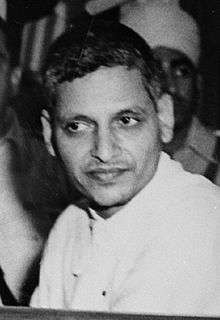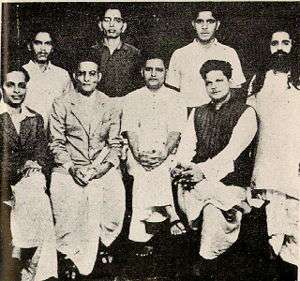Nathuram Godse
Nathuram Vinayak Godse (19 May 1910 – 15 November 1949) was the assassin of Mahatma Gandhi, who shot Gandhi in the chest three times at point blank range in New Delhi on 30 January 1948.[1] Godse, an advocate of Hindu nationalism, from Pune, Maharashtra, who believed Gandhi to have favored the political demands of India's Muslims during the partition of India, plotted the assassination with Narayan Apte and six others. After a trial that lasted over a year, Godse was sentenced to death on 8 November, 1949. Although pleas for commutation were made by Gandhi's two sons, Manilal Gandhi and Ramdas Gandhi, they were turned down by India's prime minister Jawaharlal Nehru, deputy prime minister Vallabhbhai Patel, and the Governor-General C. Rajagopalachari.[2] Godse was hanged in the Ambala Central Jail on 15 November 1949.[3]
Nathuram Vinayak Godse | |
|---|---|
 Nathuram Godse at his trial for the murder of Mahatma Gandhi | |
| Born | Ramachandra Vinayak Godse 19 May 1910 |
| Died | 15 November 1949 (aged 39) |
| Cause of death | Execution by hanging |
| Nationality | Indian |
| Organization | Rashtriya Swayamsevak Sangh Hindu Mahasabha |
| Criminal status | Executed |
| Criminal charge | Murder (Assassination of Mahatma Gandhi) |
| Penalty | Death |
Early life
Nathuram Vinayakrao Godse was born into a Maharashtrian Chitpavan Brahmin family.[4] His father, Vinayak Vamanrao Godse, was a postal employee; his mother was Lakshmi (née Godavari). At birth, he was named Ramachandra.[5] Nathuram was given his name because of an unfortunate incident. Before he was born, his parents had three sons and a daughter, with all three boys dying in their infancy. Fearing a curse that targeted male children, young Ramachandra was brought up as a girl for the first few years of his life, including having his nose pierced and being made to wear a nose-ring (nath in Marathi). It was then that he earned the nickname "Nathuram" (literally "Ram with a nose-ring"). After his younger brother was born, they switched to treating him as a boy.[6]
Godse attended the local school at Baramati through the fifth standard, after which he was sent to live with an aunt in Pune so that he could study at an English-language school. During his school days, he highly respected Gandhi.[7]
Political career and beliefs

Godse dropped out of high school and became an activist with Hindu nationalist organizations Rashtriya Swayamsevak Sangh (National Volunteer Organisation) and Hindu Mahasabha, although the exact dates of his membership are uncertain.[8][9]
RSS membership
Godse joined RSS in Sangli (Maharashtra) in 1932 as a boudhik karyawah (ground worker), and simultaneously remained a member of the Hindu Mahasabha, both right wing organizations. He often wrote articles in newspapers to publicise his thoughts. During this time, Godse and M. S. Golwalkar, later RSS chief, often worked together, and they translated Babarao Savarkar's book "Rashtra Mimansa" into English. They had a falling out when Golwalkar took the entire credit for this translation. In the early 1940s, Godse formed his own organization, "Hindu Rashtra Dal"[10] on the Vijayadashami day of 1942, though he continued to remain a member of the RSS and Hindu Mahasabha.[11]
In 1946, Godse claimed to have left the RSS and moved to the Hindu Mahasabha over the issue of the partition of India. However, historical sources do not corroborate this claim; an investigation published by The Caravan in January 2020 revealed that up until his final days, Godse was listed as a member in records kept by the RSS of meetings that took place long after he was supposed to have left the organisation.[12] His family has also said that he had never left the RSS, highlighting that he held membership at the RSS as well as the Hindu Mahasabha. [13] Godse's 1946 claim is also refuted by his first deposition in Marathi after he assassinated Gandhi, where he says that while he did join the Hindu Mahasabha, "I remained active in Rashtriya Swayamsevak Sangh."
Assassination of Mahatma Gandhi
At 5:17 PM on 30 January 1948, as Gandhi made his way to a prayer meeting on a raised lawn behind Birla House, a mansion in New Delhi, where he was staying, Godse stepped out of the crowd flanking his path to the dais. He fired three bullets into Gandhi's chest.[14] Gandhi fell immediately, sending the attendant crowd into a state of shock.[14] Herbert Reiner Jr., a 32-year-old vice-consul at the new American embassy in Delhi, was the first to rush forward and grasp Godse by the shoulders, spinning him into the arms of some military personnel, who disarmed him.[15][16] Reiner then held Godse by the neck and shoulders until he was taken away by the military and police.[17][18] Reiner reported later that in the moments before he apprehended him, Godse looked a little stunned at how easily he had carried out his plan.[19] Gandhi was taken back to his room in Birla House, where he died soon thereafter.[20]
Trial and execution
Godse was put on trial at the Punjab High Court, at Peterhoff, Shimla. On 8 November 1949, he was sentenced to death. Although pleas for commutation were made by Gandhi's two sons, Manilal Gandhi and Ramdas Gandhi, they were turned down by India's prime minister Jawaharlal Nehru, deputy prime minister Vallabhbhai Patel and the Governor-General Chakravarti Rajagopalachari,[2] and Godse was hanged at Ambala Jail on 15 November 1949.[3]
Aftermath
Millions of Indians mourned Gandhi's assassination; the Hindu Mahasabha was vilified and the Rashtriya Swayamsevak Sangh was temporarily banned.
The RSS has consistently denied any connection with Godse. It has maintained that Godse "left RSS in the mid-1930s".[9] However, Nathuram Godse's brother Gopal Godse stated that all the Godse brothers were members of the RSS at the time of the assassination and blamed the RSS for disowning them.[21] The other members of the Godse's family too have denied that he ever left the RSS. "He remained a boudhik karyawah till his death."[11]
Attempts at rehabilitation
In 2014, following the Bharatiya Janata Party's rise to power, the Hindu Mahasabha began attempts to rehabilitate Godse and portray him as a patriot. It requested Prime Minister Narendra Modi to install the bust of Godse. It created a documentary film Desh Bhakt Nathuram Godse (Patriot Nathuram Godse) for release on the death anniversary of Gandhi on 30 January 2015.[22] There were attempts to build a temple for Godse and to celebrate 30 January as a Shaurya Diwas ("Bravery Day").[23] A civil suit was filed in Pune Court asking for a ban on the documentary film.[24]
In May 2019, in the lead up to the final phase of Indian elections, BJP's candidate from Bhopal, Pragya Thakur, called Godse a "patriot".[25] Facing intense backlash, she apologized later.[26]
As Hindu nationalism swells in India, statues and temples are being raised in Godse's honor, and the city of Meerut may be renamed for him.[27]
In art
- Nine Hours to Rama, Stanley A. Wolpert (1962)[28]
References
- Noorani, A.G. (8 February 2013). "The BJP and Nathuram Godse". Frontline. Retrieved 4 July 2017.
- Gandhi, Rajmohan (2006), Gandhi: The Man, His People, and the Empire, University of California Press, p. 660, ISBN 978-0-520-25570-8
- Bandyopadhyay, Sekhar (2009), Decolonization in South Asia: Meanings of Freedom in Post-independence West Bengal, 1947–52, Routledge, p. 146, ISBN 978-1-134-01824-6
- Devare, Aparna (3 April 2013). History and the Making of a Modern Hindu Self. ISBN 9781136197086. Retrieved 9 September 2016.
- "Early life | Nathuram Godse". Nathuram.com. Retrieved 30 January 2014.
- Jeffrey, Robin (1990). India, Rebellion to Republic: Selected Writings, 1857–1990. Sterling Publishers. p. 105.
- Time (14 February 2000) "His Principle of Peace Was Bogus".
- The Hindu (18 August 2004). "RSS releases 'proof' of its innocence". Retrieved 26 June 2007
- IANS, RSS denies Godse was its member, rebuts Cong claim, Zee News, 30 December 2010
- Hansen, Thomas Blom (1999). The Saffron Wave: Democracy and Hindu Nationalism in Modern India. Princeton University Press. p. 249. ISBN 1-4008-2305-6.
- Venugopal, Vasudha (8 September 2016). "Nathuram Godse never left RSS, says his family". Economic times. Retrieved 4 July 2017.
- Jha, Dhirendra K. "The Apostle of Hate". The Caravan. Delhi Press. Retrieved 8 January 2020.
- Venugopal, Vasudha (8 September 2016). "Nathuram Godse never left RSS, says his family" – via The Economic Times.
- Pronko, N. H.; Bowles, J. W. (2013), Empirical Foundations Of Psychology, Taylor & Francis, p. 343, ISBN 978-1-136-32708-7
- Obituary, May 26 (26 May 2000), "Herbert Reiner Jr.; Captured Gandhi's killer", Los Angeles Times, retrieved 27 January 2017
- Pronko, N. H.; Bowles, J. W. (2013), Empirical Foundations Of Psychology, Taylor & Francis, p. 343, ISBN 978-1-136-32708-7
- Obituary, May 21 (21 May 2000), "Herbert Reiner Jr., Diplomat, 83; Captured Gandhi's killer in 1948", The Boston Globe
- Trumbull, Robert (31 January 1948), "Gandhi is killed by a Hindu; India shaken; World mourns; 15 die in rioting in Bombay", The New York Times
- Stratton, Roy Olin (1950), SACO, the Rice Paddy Navy, C. S. Palmer Publishing Company, pp. 40–42
- "Controversy over "Hey Ram"". Archived from the original on 1 February 2008. Retrieved 9 October 2013.CS1 maint: BOT: original-url status unknown (link)
- A.G. Noorani. "The BJP and Nathuram Godse". Frontline.
- Ghose, Debobrat (21 December 2014). "Hindu Mahasabha head speaks to FP: Godse was a 'martyr' and 'patriot'". Firstpost. Retrieved 21 December 2014.
- "Hindu Mahasabha announces Godse temple". Deccan Chronicle. 24 December 2014.
- PTI (25 December 2014). "Pune court to hear suit against Godse film". The Hindu.
- "'Nathuram Godse was a patriot,' says BJP's Pragya Thakur; sparks outrage". www.hindustantimes.com. 16 May 2019. Retrieved 16 May 2019.
- "Under fire, BJP's Pragya Thakur apologises for calling Godse a 'deshbhakt'". The Indian Express. 16 May 2019. Retrieved 16 May 2019.
- Yasir, Sameer (4 February 2020). "Gandhi's Killer Evokes Admiration as Never Before". The New York Times. ISSN 0362-4331. Retrieved 5 February 2020.
- Long, Roger D. (2004). Charisma and Commitment in South Asian History: Essays Presented to Stanley ... - Google Books. ISBN 9788125026419. Retrieved 30 January 2014.
Further reading
- Report of Commission of Inquiry in to Conspiracy to Murder Mahatma Gandhi (1969)
- Elst, Koenraad, Gandhi and Godse – a Review and a Critique, Voice of India, 2001. ISBN 81-85990-71-9
- Godse, Nathuram, Why I Assassinated Mahatma Gandhi, Surya Bharti, Delhi, India, 2003. OCLC 33991989
- Godse, Nathuram May it Please Your Honor!, Surya Bharti, India, 2003
- Khosla, G.D., Murder of the Mahatma and Other Cases from a Judge's Notebook, Jaico Publishing House, 1968. ISBN 0-88253-051-8
- Malgonkar, Manohar (2008). The Men Who Killed Gandhi, New Delhi: Roli Books, ISBN 978-81-7436-617-7
- Phadke, Y.D., Nathuramayan
- Pradeep Dalvi’s, "Me Nathuram Godse Boltoy" narrations by robby Raju pathak
External links
- Time Magazine's February 2000 interview of Gopal Godse
- Article discussing Why Godse Killed Gandhi
- Rediff's January 1998 interview of Gopal Godse
- Article discussing pro-Godse play
- Eyewitness to Gandhi assassination
- Eyewitness: Mahatma Gandhi Assassination on YouTube
- First Information Report (FIR) by police
- "An Assassin Speaks" written by Gopal Godse, narrated by Navneet singh